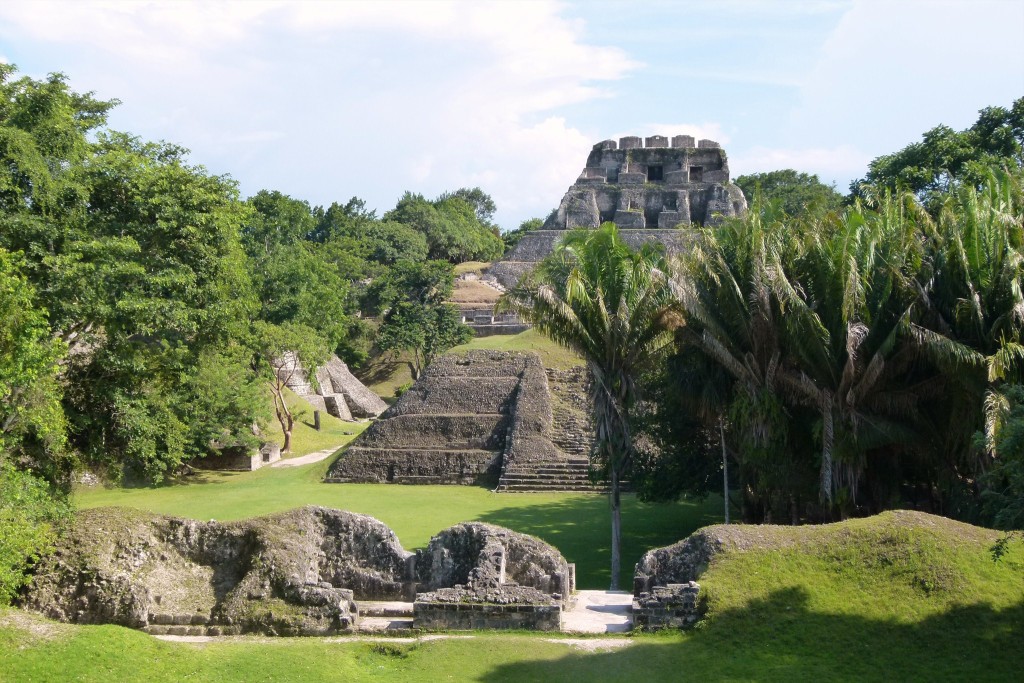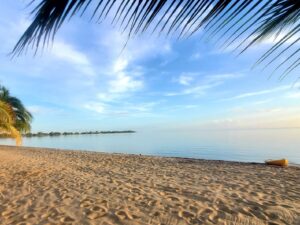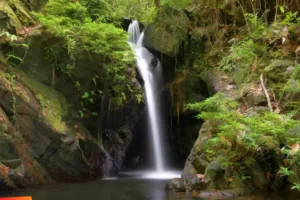
Easily recognizable from space, the Belize Blue Hole, sometimes known as the Great Blue Hole, is one of the most iconic dive spots in Belize.
Here are 10 fascinating facts about the Belize Blue Hole:
1 – Size and Dimensions
The Belize Blue Hole is almost perfectly circular in shape, measuring 300 meters (984 feet) across and 108 meters (354 feet) deep.
2 – The Largest Sea Hole in the World
The Belize Blue Hole is the largest sea hole in the world. Sea holes refer to caves that were submerged when rising waters covered them. Most sea holes, just like the Belize Blue Hole, were submerged at the end of the last great Ice Age some 10,000 years ago.
3 – Location
The Belize Blue Hole is located approximately 100 kilometers (62 miles) offshore of Belize City. The perimeter of the Blue Hole is Lighthouse Reef, a natural coral atoll.
4 – Stalactites and Stalagmites
Divers can explore thousands of stalactites and stalagmites that were formed when the Blue Hole was an aboveground series of caverns.
5 – Jacques Cousteau
Legendary French documentarian and marine biologist Jacques Cousteau visited the Blue Hole in 1971. He later described the Blue Hole as one of his top favorite 10 dive sites in the world.
6 – The Name
The name “Great Blue Hole” comes from British diver Ned Middleton who wrote a book about his career as a diver in 1988 named “Ten Years Underwater”. Although the Blue Hole was charted by the Spanish, no one is sure what name they gave for the region.
7 – Discovery Channel
In 2012, the Discovery Channel ranked the Belize Blue Hole as the #1 most amazing place on Earth.
8 – UNESCO World Heritage Site
The Belize Blue Hole is a UNESCO World Heritage Site, part of a vast barrier reef that is the second-largest barrier reef in the world after Australia’s Great Barrier Reef.
9 – Charles Darwin
In 1836, on his around the world voyage aboard the HMS Beagle, Charles Darwin visited the Belize Barrier Reef and declared it the “most remarkable coral reefs” in the entire Caribbean.
10 – Experienced Divers Only
Due to the challenges of diving the Belize Blue Hole, only divers who have completed at least 24 divers are allowed to explore the Belize Blue Hole.
About The Belize Blue Hole
Due to the complexity and depth of the dive, only experienced divers are permitted to explore the majestic underwater formations that make the Belize Blue Hole such a unique dive site.
The Blue Hole is located along the Belize Barrier Reef, a UNESCO World Heritage Site part of the second-largest barrier reef system in the world.
An almost perfectly circular area of dark topaz water encircled by the Lighthouse Atoll on the Belize Barrier reef, the Great Blue Hole is one of the most intriguing and popular places to dive anywhere on Planet Earth.
Facts About The Belize Blue Hole
1.) The Blue Hole measures about 1,000 feet in circumference and is more than 400 feet deep. It is the largest natural formation of this type found anywhere in the world.
2.) The Blue Hole was formed at the end of the last Ice Age when rising seawaters flooded a series of enormous caverns. Geologists have determined that the caves first formed about 153,000 years ago and were completely submerged approximately 15,000 years ago.
3.) The Blue Hole is approximately 60 miles offshore from Belize City and is part of the Belize Barrier Reef, a UNESCO World Heritage Site.
4.) In 1971, famed French marine biologist Jacques Cousteau visited the Blue Hole with his boat Calypso, declaring it one of the top 10 diving spots on the planet.
5.) The underwater caves of the Blue Hole are filled with giant stalactites, proof that it once existed above water.
6.) The Blue Hole is home to several species of sharks, including bull sharks, Caribbean reef sharks, and the elusive hammerhead shark.
7.) In 2012, the Discovery Channel ranked the Blue Hole as #1 on its list of 10 Most Amazing Places on Earth.
8.) The Blue Hole is visible from space, easily identifiable by its unique circular formation and location within the midst of the greater Belize Barrier Reef.
9.) The name “Blue Hole” was coined by the British diver Ned Middleton in his book “10 Years Underwater” published in 1988.
10.) Due to the complexity of diving required, the Blue Hole is restricted to experienced divers only with a minimum of 24 completed dives.
What It’s Really Like To Dive The Great Blue Hole
The Mysterious Belize Great Blue Hole is a large underwater hole off the coast of Belize. It lies near the center of Lighthouse Reef, a small atoll 100 kilometers (62 mi) from the mainland and Belize City. The hole is perfectly circular in shape, over 300 meters (1000 ft) across, 3140 feet circumference and 125 meters (410 ft) deep.
Read also: Dive the Great Blue Hole of Belize with this Vacation Package
It was formed as a limestone cave system during the last glacial period when the sea level was 400 to 500 feet below present time and was dry land. Last glacial period began about 120,000 years ago and end about 15,000 years ago. Reaching the maximum extension 26,500 years ago. At the end the ocean began to rise, the caves flooded, and the roof collapsed.
Believed to be the world’s largest feature of its kind, the Great Blue Hole is part of the larger Belize Barrier Reef Reserve System, a World Heritage site of the United Nations Educational, Scientific and Cultural Organization (UNESCO).
The hole itself is the opening to a system of caves and passageway that penetrate this undersea mountain. In various places, massive limestone stalactites hang down from what was once the ceiling of air-filled caves thousand of years before the end of the last Ice Age 15,000 years ago. When the ice melted the sea level rose, flooding the caves. This process occurred in stages. Evidence for this are the shelves and ledges, carved into the limestone by the sea, which run the complete interior circumference of the Blue Hole at various depths.
The Blue Hole is a “karst- eroded sinkhole.” It was once a cave at the center of an underground tunnel complex whose ceiling collapsed. Some of the tunnels are thought to be linked right through to the mainland, though this has never been conclusively proved. Notable are the large population of sharks such as lemon, black tip, reef, hammerhead, and bull sharks.
Mysterious and legends always have been around the Belize Blue Hole.
Read also: Scuba Dive the Great Belize Barrier Reef with this Vacation Package
This was the entrance to Xibalba?. It’s the kind of underwater geology that inspires speculation about aliens creating geometrically perfect anomalies, mermaids and monsters living in darkness.
I explored the bottom of the Blue Hole perimeter (3,140 feet circumference). To do this I dove down twice, reaching the depth of 375′ feet which took 4 to 5 hours of diving each day.
Video Music:
Start to 2:18 min. “Dawn From Four Sea Interludes” by Benjamin Britten
2:18 to 4:37 min. “300 Violin Orchestra” by Jorge Quintero
4:37 to End “Groove Armada” from Tomb Raider Soundtrack
Video and Blog courtesy of Ramon Llaneza
If you would like to explore the wonders of the Belize Blue Hole, the resort of Chabil Mar has a comprehensive scuba diving vacation package that includes a guided trip to the Blue Hole.
For more information about the Blue Hole or Belize, feel free to chat with our Concierge at: concierge@chabilmarvillas.com or contact our Reservations Manager at: reservations@chabilmarvillas.com. Or perhaps you would like to call toll free from the US or Canada: 1-866-417-2377.













So fascinating!
We are very pleased to know you enjoyed our blog on the Blue Hole in Belize
What was found at bottom of hole?
There is much to see during the dive into the Belize Blue Hole, a World Heritage Destination! We suggest that you google that question or search for videos on YouTube at: Belize Blue Hole!
cool :]
Happy you liked that post. Have a great day. Thank you for your comment.
great place to visit, thank you for creating this article
Yes, the blue hole is a great place to visit and a World Heritage Site. We are pleased that you liked the article.
What are the conservation efforts in place to protect the Blue Hole and its surrounding ecosystem?
Thank you for your comment. You can google conservation efforts of the Belize Barrier Reef and Blue Hole to see many sights that reference this information.